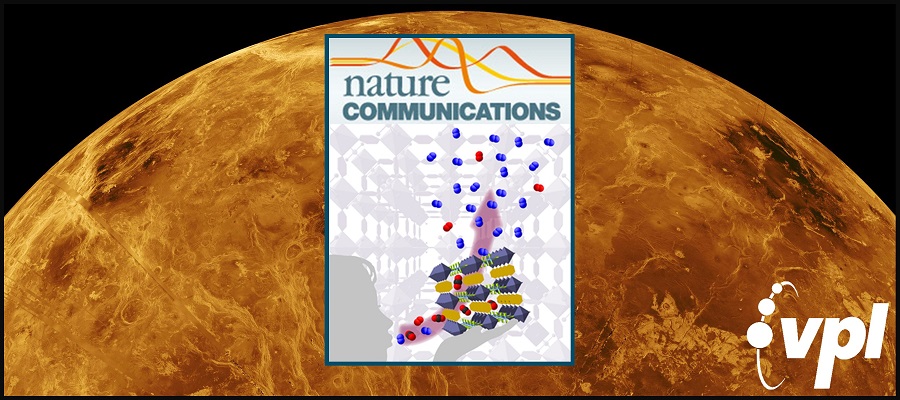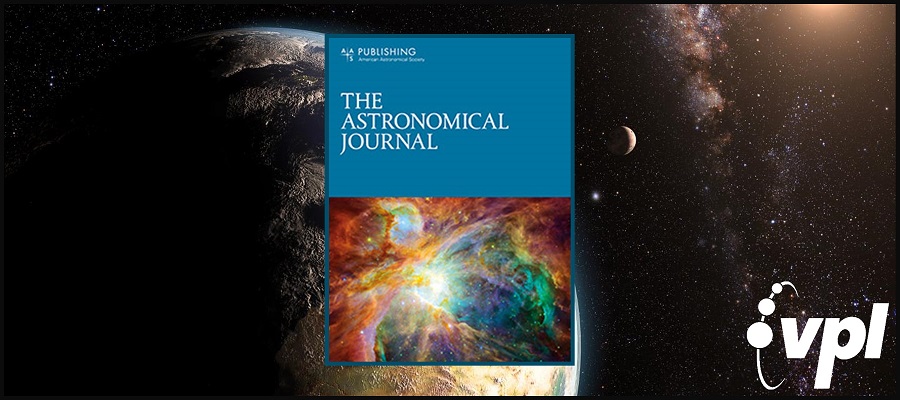Each year, AGU recognizes individuals and teams for their accomplishments in research, education, science communication and outreach. Honorees and their…
VPL Postdoctoral Researcher, Andrew Lincowski (University of Washington), and VPL project PI, Victoria Meadows (University of Washington), published two new…
The observation of a 266.94 GHz feature in the Venus spectrum has been attributed to phosphine (PH3) in the Venus clouds, suggesting unexpected geological, chemical, or even biological processes. Since both PH3 and sulfur dioxide (SO2) are spectrally active near 266.94 GHz, the contribution to this line from SO2 must be determined before it can be attributed, in whole or part, to PH3. An undetected SO2 reference line, interpreted as an unexpectedly low SO2 abundance, suggested that the 266.94 GHz feature could be attributed primarily to PH3. However, the low SO2 and the inference that PH3 was in the cloud deck posed an apparent contradiction. Here we use a radiative transfer model to analyze the PH3 discovery, and explore the detectability of different vertical distributions of PH3 and SO2. We find that the 266.94 GHz line does not originate in the clouds, but above 80 km in the Venus mesosphere. This level of line formation is inconsistent with chemical modeling that assumes generation of PH3 in the Venus clouds. Given the extremely short chemical lifetime of PH3 in the Venus mesosphere, an implausibly high source flux would be needed to maintain the observed value of 20 ± 10 ppb. We find that typical Venus SO2 vertical distributions and abundances fit the JCMT 266.94 GHz feature, and the resulting SO2 reference line at 267.54 GHz would have remained undetectable in the ALMA data due to line dilution. We conclude that nominal mesospheric SO2 is a more plausible explanation for the JCMT and ALMA data than PH3.
Point-source spectrophotometric (single-point) light curves of Earth-like planets contain a surprising amount of information about the spatial features of those worlds. Spatially resolving these light curves is important for assessing time-varying surface features and the existence of an atmosphere, which in turn is critical to life on Earth and significant for determining habitability on exoplanets. Given that Earth is the only celestial body confirmed to harbor life, treating it as a proxy exoplanet by analyzing time-resolved spectral images provides a benchmark in the search for habitable exoplanets. The Earth Polychromatic Imaging Camera (EPIC) on the Deep Space Climate Observatory (DSCOVR) provides such an opportunity, with observations of ~5000 full-disk sunlit Earth images each year at 10 wavelengths with high temporal frequency. We disk-integrate these spectral images to create single-point light curves and decompose them into principal components (PCs). Using machine-learning techniques to relate the PCs to six preselected spatial features, we find that the first and fourth PCs of the single-point light curves, contributing ~83.23% of the light-curve variability, contain information about low and high clouds, respectively. Surface information relevant to the contrast between land and ocean reflectance is contained in the second PC, while individual land subtypes are not easily distinguishable (<0.1% total light-curve variation). We build an Earth model by systematically altering the spatial features to derive causal relationships to the PCs. This model can serve as a baseline for analyzing Earth-like exoplanets and guide wavelength selection and sampling strategies for future observations.
The abundance of SO dimers (SO)2 in the upper atmosphere of Venus and their implications for the enigmatic ultraviolet absorption has been investigated in several studies over the past few years. However, the photochemistry of sulfur species in the upper atmosphere of Venus is still not well understood and the identity of the missing ultraviolet absorber(s) remains unknown. Here we update an existing photochemical model of Venus’ upper atmosphere by including the photochemistry of SO dimers. Although the spectral absorption profile of SO dimers fits the unknown absorber, their abundance is found to be too low for them to contribute significantly to the absorption. It is more likely that their photolysis and/or reaction products could contribute more substantively. Reactions of SO dimers are found to be important sources of S2O, and possibly higher order SnO species and polysulfur, Sn. All of these species absorb in the critical ultraviolet region and are expected to be found in both the aerosol and gas phase. indicating that in-situ high resolution aerosol mass spectrometry might be a useful technique for identifying the ultraviolet absorber on Venus.
Point source spectrophotometric (“single-point”) light curves of Earth-like planets contain a surprising amount of information about the spatial features of those worlds. Spatially resolving these light curves is important for assessing time-varying surface features and the existence of an atmosphere, which in turn is critical to life on Earth and significant for determining habitability on exoplanets. Given that Earth is the only celestial body confirmed to harbor life, treating it as a proxy exoplanet by analyzing time-resolved spectral images provides a benchmark in the search for habitable exoplanets. The Earth Polychromatic Imaging Camera (EPIC) on the Deep Space Climate Observatory (DSCOVR) provides such an opportunity, with observations of ~5000 full-disk sunlit Earth images each year at ten wavelengths with high temporal frequency. We disk-integrate these spectral images to create single-point light curves and decompose them into principal components (PCs). Using machine learning techniques to relate the PCs to six preselected spatial features, we find that the first and fourth PCs of the single-point light curves, contributing ~83.23% of the light curve variability, contain information about low and high clouds, respectively. Surface information relevant to the contrast between land and ocean reflectance is contained in the second PC, while individual land sub-types are not easily distinguishable (<0.1% total light curve variation). We build an Earth model by systematically altering the spatial features to derive causal relationships to the PCs. This model can serve as a baseline for analyzing Earth-like exoplanets and guide wavelength selection and sampling strategies for future observations.
The current goals of the astrobiology community are focused on developing a framework for the detection of biosignatures, or evidence thereof, on objects inside and outside of our solar system. A fundamental aspect of understanding the limits of habitable environments (surface liquid water) and detectable signatures thereof is the study of where the boundaries of such environments can occur. Such studies provide the basis for understanding how a once inhabitable planet might come to be uninhabitable
The TRAPPIST-1 planetary system provides an unprecedented opportunity to study terrestrial exoplanet evolution with the James Webb Space Telescope (JWST) and ground-based observatories. Since M dwarf planets likely experience extreme volatile loss, the TRAPPIST-1 planets may have highly evolved, possibly uninhabitable atmospheres. We used a versatile, 1D terrestrial planet climate model with line-by-line radiative transfer and mixing length convection (VPL Climate) coupled to a terrestrial photochemistry model to simulate environmental states for the TRAPPIST-1 planets. We present equilibrium climates with self-consistent atmospheric compositions and observational discriminants of postrunaway, desiccated, 10–100 bar O2- and CO2-dominated atmospheres, including interior outgassing, as well as for water-rich compositions
(The Astrophysical Journal, 2018)
Solar and thermal radiation are critical aspects of planetary climate, with gradients in radiative energy fluxes driving heating and cooling. Climate models require that radiative transfer tools be versatile, computationally efficient, and accurate. Here, we describe a technique that uses an accurate full-physics radiative transfer model to generate a set of atmospheric radiative quantities which can be used to linearly adapt radiative flux profiles to changes in the atmospheric and surface state—the Linearized Flux Evolution (LiFE) approach. These radiative quantities describe how each model layer in a plane-parallel atmosphere reflects and transmits light, as well as how the layer generates diffuse radiation by thermal emission and by scattering light from the direct solar beam. By computing derivatives of these layer radiative properties with respect to dynamic elements of the atmospheric state, we can then efficiently adapt the flux profiles computed by the full-physics model to new atmospheric states. We validate the LiFE approach, and then apply this approach to Mars, Earth, and Venus, demonstrating the information contained in the layer radiative properties and their derivatives, as well as how the LiFE approach can be used to determine the thermal structure of radiative and radiative-convective equilibrium states in one-dimensional atmospheric models.
We observed Venus with the Apache Point Observatory 3.5 m telescope TripleSpec spectrograph (R = 3500, λ = 0.96–2.47 µm) on 1–3 March 2009 and on 25, 27, and 30 November and 2–4 December 2010. With these observations and synthetic spectra generated with the Spectral Mapping and Atmospheric Radiative Transfer model, we produce the first simultaneous maps of cloud opacity, acid concentration, water vapor (H2O), hydrogen chloride (HCl), carbon dioxide (CO), carbonyl sulfide (OCS), and sulfur dioxide (SO2) abundances in the Venusian lower atmosphere.
We present a new method to probe atmospheric pressure on Earth-like planets using (O2-O2) dimers in the near-infrared. We also show that dimer features could be the most readily detectable biosignatures for Earth-like atmospheres and may even be detectable in transit transmission with the James Webb Space Telescope (JWST). The absorption by dimers changes more rapidly with pressure and density than that of monomers and can therefore provide additional information about atmospheric pressures.
Observations by the SPICAV/SOIR instruments aboard Venus Express have revealed that the upper haze (UH) of Venus, between 70 and 90 km, is variable on the order of days and that it is populated by two particle modes. We use a one-dimensional microphysics and vertical transport model based on the Community Aerosol and Radiation Model for Atmospheres to evaluate whether interaction of upwelled cloud particles and sulfuric acid particles nucleated in situ on meteoric dust are able to generate the two observed modes, and whether their observed variability are due in part to the action of vertical transient winds at the cloud tops. Nucleation of photochemically produced sulfuric acid onto polysulfur condensation nuclei generates mode 1 cloud droplets, which then diffuse upwards into the UH. Droplets generated in the UH from nucleation of sulfuric acid onto meteoric dust coagulate with the upwelled cloud particles and therefore cannot reproduce the observed bimodal size distribution. By comparison, the mass transport enabled by transient winds at the cloud tops, possibly caused by sustained subsolar cloud top convection, are able to generate a bimodal size distribution in a time scale consistent with Venus Express observations.
Exoplanet atmosphere spectroscopy enables us to improve our understanding of exoplanets just as remote sensing in our own solar system has increased our understanding of the solar system bodies. The challenge is to quantitatively determine the range of temperatures and molecular abundances allowed by the data, which is often difficult given the low information content of most exoplanet spectra that commonly leads to degeneracies in the interpretation. A variety of spectral retrieval approaches have been applied to exoplanet spectra, but no previous investigations have sought to compare these approaches. We compare three different retrieval methods: optimal estimation, differential evolution
The atmospheres of terrestrial planets are expected to be in long-term radiation balance: an increase in the absorption of solar radiation warms the surface and troposphere, which leads to a matching increase in the emission of thermal radiation. Warming a wet planet such as Earth would make the atmosphere moist and optically thick such that only thermal radiation emitted from the upper troposphere can escape to space. Hence, for a hot moist atmosphere, there is an upper limit on the thermal emission that is unrelated to surface temperature. If the solar radiation absorbed exceeds this limit, the planet will heat uncontrollably and the entire ocean will evaporate—the so-called runaway greenhouse. Here we model the solar and thermal radiative transfer in incipient and complete runaway greenhouse atmospheres at line-by-line spectral resolution using a modern spectral database. We find a thermal radiation limit of 282 W m−2 (lower than previously reported) and that 294 W m−2 of solar radiation is absorbed (higher than previously reported). Therefore, a steam atmosphere induced by such a runaway greenhouse may be a stable state for a planet receiving a similar amount of solar radiation as Earth today. Avoiding a runaway greenhouse on Earth requires that the atmosphere is subsaturated with water, and that the albedo effect of clouds exceeds their greenhouse effect. A runaway greenhouse could in theory be triggered by increased greenhouse forcing, but anthropogenic emissions are probably insufficient.
The EPOXI Discovery Mission of Opportunity reused the Deep Impact flyby spacecraft to obtain spatially and temporally resolved visible photometric and moderate resolution near-infrared (NIR) spectroscopic observations of Earth. These remote observations provide a rigorous validation of whole-disk Earth model simulations used to better understand remotely detectable extrasolar planet characteristics. We have used these data to upgrade, correct, and validate the NASA Astrobiology Institute’s Virtual Planetary Laboratory three-dimensional line-by-line, multiple-scattering spectral Earth model. This comprehensive model now includes specular reflectance from the ocean and explicitly includes atmospheric effects such as Rayleigh scattering, gas absorption, and temperature structure. We have used this model to generate spatially and temporally resolved synthetic spectra and images of Earth for the dates of EPOXI observation.
Glint, the specular reflection of sunlight off Earth’s oceans, may reveal the presence of oceans on an extrasolar planet. As an Earth-like planet nears crescent phases, the size of the ocean glint spot increases relative to the fraction of the illuminated disk, while the reflectivity of this spot increases. Both effects change the planet’s visible reflectivity as a function of phase. However, strong forward scattering of radiation by clouds can also produce increases in a planet’s reflectivity as it approaches crescent phases, and surface glint can be obscured by Rayleigh scattering and atmospheric absorption. Here, we explore the detectability of glint in the presence of an atmosphere and realistic phase-dependent scattering from oceans and clouds. We use the NASA Astrobiology Institute’s Virtual Planetary Laboratory three-dimensional line-by-line, multiple-scattering spectral Earth model to simulate Earth’s broadband visible brightness and reflectivity over an orbit. Our validated simulations successfully reproduce phase-dependent Earthshine observations. We find that the glinting Earth can be as much as 100% brighter at crescent phases than simulations that do not include glint, and that the effect is dependent on both orbital inclination and wavelength, where the latter dependence is caused by Rayleigh scattering limiting sensitivity to the surface. We show that this phenomenon may be observable using the James Webb Space Telescope paired with an external occulter.
Previous research has indicated that high amounts of ozone (O3) and oxygen (O2) may be produced abiotically in atmospheres with high concentrations of CO2. The abiotic production of these two gases, which are also characteristic of photosynthetic life processes, could pose a potential “false-positive” for remote-sensing detection of life on planets around other stars.We show here that such false positives are unlikely on any planet that possesses abundant liquid water, as rainout of oxidized species onto a reduced planetary surface should ensure that atmospheric H2 concentrations remain relatively high, and that O2 and O3 remain low. Our aim is to determine the amount of O3 and O2 formed in a high CO2 atmosphere for a habitable planet without life. We use a photochemical model that considers hydrogen (H2) escape and a detailed hydrogen balance to calculate the O2 and O3 formed on planets with 0.2 of CO2 around the Sun, and 0.02, 0.2 and 2 bars of CO2 around a young Sun-like star with higher UV radiation. The concentrations obtained by the photochemical model were used as input in a radiative transfer model that calculated the spectra of the modeled planets. The O3 and O2 concentrations in the simulated planets are extremely small, and unlikely to produce a detectable signature in the spectra of those planets. We conclude that with a balanced hydrogen budget, and for planets with an active hydrological cycle, abiotic formation of O2 and O3 is unlikely to create a possible false positive for life detection in either the visible/near-infrared or mid-infrared wavelength regimes.
As photosynthesis on Earth produces the primary signatures of life that can be detected astronomically at the global scale, a strong focus of the search for extrasolar life will be photosynthesis, particularly photosynthesis that has evolved with a different parent star. We take previously simulated planetary atmospheric compositions for Earth-like planets around observed F2V and K2V, modeled M1V and M5V stars, and around the active M4.5V star AD Leo; our scenarios use Earth’s atmospheric composition as well as very low O2 content in case anoxygenic photosynthesis dominates. With a line-by-line radiative transfer model, we calculate the incident spectral photon flux densities at the surface of the planet and under water. We identify bands of available photosynthetically relevant radiation and find that photosynthetic pigments on planets around F2V stars may peak in absorbance in the blue, K2V in the red-orange, and M stars in the near-infrared, in bands at 0.93–1.1 μm, 1.1–1.4 μm, 1.5–1.8 μ m, and 1.8–2.5 μm.
Coupled one-dimensional photochemical-climate calculations have been performed for hypothetical Earth-like planets around M dwarfs. Visible/near-infrared and thermal-infrared synthetic spectra of these planets were generated to determine which biosignature gases might be observed by a future, space-based telescope. Our star sample included two observed active M dwarfs—AD Leo and GJ 643—and three quiescent model stars. The spectral distribution of these stars in the ultraviolet generates a different photochemistry on these planets. As a result, the biogenic gases CH4, N2O, and CH3Cl have substantially longer lifetimes and higher mixing ratios than on Earth, making them potentially observable by space-based telescopes. On the active M-star planets, an ozone layer similar to Earth’s was developed that resulted in a spectroscopic signature comparable to the terrestrial one. The simultaneous detection of O2 (or O3) and a reduced gas in a planet’s atmosphere has been suggested as strong evidence for life. Planets circling M stars may be good locations to search for such evidence. Key Words: Habitable planets—M dwarfs—Biosignatures—Biomarkers—Terrestrial Planet Finder. Astrobiology 5, 706–725.
Coupled radiative-convective/photochemical modeling was performed for Earth-like planets orbiting different types of stars (the Sun as a G2V, an F2V, and a K2V star). O2 concentrations between 1 and 10-5 times the present atmospheric level (PAL) were simulated. The results were used to calculate visible/near-IR and thermal-IR spectra, along with surface UV fluxes and relative dose rates for erythema and DNA damage. For the spectral resolution and sensitivity currently planned for the first generation of terrestrial planet detection and characterization missions, we find that O2 should be observable remotely in the visible for atmospheres containing at least 10-2 PAL of O2. O3 should be visible in the thermal-IR for atmospheres containing at least 10-3 PAL of O2. CH4 is not expected to be observable in 1 PAL O2 atmospheres like that of modern Earth, but it might be observable at thermal-IR wavelengths in “mid-Proterozoic-type” atmospheres containing ~ 10-1 PAL of O2. Thus, the simultaneous detection of both O3 and CH4 – considered to be a reliable indication of life – is within the realm of possibility. High-O2 planets orbiting K2V and F2V stars are both better protected from surface UV radiation than is modern Earth. For the F2V case the high intrinsic UV luminosity of the star is more than offset by the much thicker ozone layer. At O2 levels below ~ 10-2 PAL, planets around all three types of stars are subject to high surface UV fluxes, with the F2V planet exhibiting the most biologically dangerous radiation environment. Thus, while advanced life is theoretically possible on high-O2 planets around F stars, it is not obvious that it would evolve as it did on Earth.



